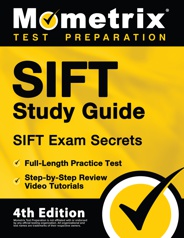The United States Army recruiters use the Selection Instrument for Flight Training (SIFT) exam to evaluate a potential future pilot’s strengths while allowing the applicant an opportunity to showcase skills in different categories. Additionally, the test is used to assist recruiters in determining an applicant’s career placement and career progression potential.
Below, you will find information on what the SIFT test is about, what the contents of the exam are, how to register for the exam, and what you can expect on exam day.
What is the SIFT Test?
The SIFT test is computer-delivered at either a Military Entrance Processing Station (MEPS) or an authorized testing center.
The three-hour testing period includes checking in at the exam site, getting situated at your testing station, an optional 15-minute break, and taking the exam. While you are allowed three hours to complete the exam, most applicants finish in less time.
SIFT Exam Outline
Seven sections comprise the SIFT exam. The first five sections have a set number of questions, and the number and type of questions in the last two sections vary. The last two sections are computer-adaptive—the computer identifies your strengths and weaknesses and selects questions to fit you personally.
I. Simple Drawings (SD)
This section aims to test your ability to quickly see images and identify the differences, identifying the “odd one out.” You have two minutes to answer 100 questions. You get about 1.2 seconds per question, so it is crucial not to spend too much time on each question.
II. Hidden Figures (HF)
You have five minutes to answer 50 questions. Each question is designed to test your ability to quickly find the hidden shapes in a complex mix of shapes and lines. You can spend no more than six seconds on each question in this section.
III. Army Aviation Information test (AAIT)
This section tests your theoretical and practical knowledge of the aspects of Army aviation. Topics include basic flight principles, types of Army aircraft, flight controls, and the physical components of an aircraft. You have 30 minutes to answer 40 questions.
IV. Spatial Apperception Test (SAT)
This section aims to assess your ability to picture a craft in three-dimensional space and your understanding of how the cockpit view corresponds to the aircraft’s position. In this section, you identify a series of cockpit view images and match them to an external view of a craft in flight and which way it is flying based on the cockpit view.
To pass this section, you need to envision the view from the cockpit depending on the craft’s position in relation to external geography. You have ten minutes to answer 25 questions.
V. Reading Comprehension Test (RCT)
Each question in this section consists of a paragraph of text and possible answers relating to the text. Only one question is exactly right, with the rest of the possible solutions relating closely to the text. The purpose is to assess general intelligence and your ability to use a logical process of elimination under pressure. You have 30 minutes to answer 20 questions.
VI. Math Skills Test (MST)
The number of questions in this section varies and is adaptive to your abilities. The computer identifies the following question based on your correct or incorrect response to the previous question. You are allowed scratch paper and a pencil to make your calculations. Topics include order of operations, algebra, geometry, and logic. This section lasts 40 minutes.
VII. Mechanical Comprehension Test (MCT)
This section lasts 15 minutes and evaluates your understanding of physical and mechanical principles. Topics include physics concepts and applications, the physics of flight, simple machines, forces, and practical problems involving scientific formulas. This section is adaptive to your abilities, choosing questions based on your responses.
Check Out Mometrix's SIFT Study Guide
Get practice questions, video tutorials, and detailed study lessons
Get Your Study Guide
How Computer-Adaptive Testing Works
The final two sections of the SIFT are computer-adaptive; depending on your performance, the difficulty of your test may increase or decrease as you go on.
Here’s a look at how it works:
The first question is judged to be of medium difficulty, and depending on your performance, the next question may be easier or harder. If you do well in the first question, the second question will be harder; conversely, if you do poorly on the first question, the second question will be easy.
Of course, the algorithm for doing well or poorly is a little imprecise, but suffice to say that the fewer questions you miss, the more likely you are to get more difficult questions.
How to Register
Contact your on-base education center if you are a current enlisted service member. The counselors in the center will talk with you and guide you through the application process. Your service recruiter will help you with the registration requirements if you are not in the military.
If you are in ROTC, Warrant Officer Flight Training (WOFT), or Officer Candidate Training, your recruiter will guide you through the registration process.
There is no cost to register and sit for the exam.

SIFT Online Prep Course
If you want to be fully prepared, Mometrix offers an online SIFT prep course designed to give you everything you need to succeed!
Here’s what you’ll find in the SIFT course:
- 60+ Review Lessons Covering Every Topic
- Over 600 SIFT Practice Questions
- 180+ Review Videos
- Money-back Guarantee
- Mobile Access
Everyone learns differently, so we’ve tailored the SIFT online prep course to ensure every learner has what they need to prepare for the SIFT exam.
Click below to check it out!
SIFT Scores
Your pass or fail results are generated immediately after the exam. The test examiner provides an official score letter, which the test examiner must sign to be official.
A passing score on the SIFT exam is 40, with a possible range of 20 to 80. The higher your score, the stronger your application packet.
Scoring Methods
The exact scoring formulas for the SIFT have not been released to the public. However, it is known that your SIFT score is compensatory, meaning that high performance on one section of the exam may offset low performance on another section.
Retaking the Exam
If you pass on your first attempt, you cannot retake the exam—your first passing score stays with you for the rest of your career. If you did not pass the exam, you can apply to retake the test after a 180-day waiting period.
You are allowed two attempts to pass the SIFT in your lifetime. If you do not pass the exam on your second try, your recruiter will help you find alternate specialty fields.
Preparing for the Test
If you want a career in Army aviation, the SIFT exam is essential. The test may seem simple, but don’t let it fool you—you must prepare and study before taking it. You cannot get the training required for a successful aviation career without a passing score.
Additionally, you can only take the test twice in your lifetime, so you must do well on the exam. Use our study guide to help you achieve the best score on your first attempt!
FAQs
Q
How long does my SIFT score last?
A
When you pass the SIFT exam, that passing score is permanent. It will last you through your entire career, which means it cannot be removed or improved upon.
Q
How hard is the SIFT test?
A
The SIFT is considered to be a moderately difficult exam if an adequate amount of preparation and studying is done before test day.
Q
How is the SIFT test graded?
A
The specifics of how the SIFT is scored are not known to the public. However, it is known that your score is calculated via a compensatory method, meaning that if you perform well on one section of the exam, it may offset poor performance on another section.
Q
Is there a paper-and-pencil version of the SIFT?
A
No, the SIFT exam is only administered via computer, which is operated on a monitored and controlled server.
Q
When will I get my SIFT scores?
A
You will receive your pass/fail SIFT score as soon as you finish the exam.
Q
How many times can I take the SIFT?
A
You can only take the SIFT two times. If you pass the exam on the first try, you are not allowed to retake the exam to improve your score. If you fail the exam, you must wait 180 days before retaking the exam. If you fail the second attempt, you will not be eligible to take the SIFT again at any time.
Q
How much does the SIFT cost to take?
A
There is no fee to register for or take the SIFT exam.
Q
Can I use a calculator on the SIFT?
A
No, calculators are not allowed to be used on the SIFT. Mathematical formulas are provided periodically as needed, but the test is designed in such a way that a calculator is not necessary.



